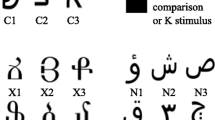Abstract
This study asked whether a paper-and-pencil protocol can be used to study stimulus equivalence, and whether stimulus equivalence can emerge from conditional discriminations established by verbal instructions. The subjects were undergraduate university students. Of the 28 subjects who acquired the baseline relations defined by the written instructions, 50% responded to those conditional relations as equivalence relations. Another 20 subjects who were not instructed in these baseline relations were probed in the same way, to examine the possibility that the subjects might inadvertently achieve a consistent pattern of responding that could be scored as stimulus equivalence despite the nonestablishment of the baseline relations. None of those subjects showed an equivalence pattern. These results demonstrate that stimulus equivalence classes can emerge in conditional relations quickly established by written instructions, and that the paper-and-pencil protocol can be used to study equivalence relations.
Similar content being viewed by others
References
CARRIGAN, P. F., & SIDMAN, M. (1992.) Conditional discriminations and equivalence relations: A theoretical analysis of control by negative stimuli. Journal of the Experimental Analysis of Behavior, 58, 183–204.
DEVANY, J. M., HAYES, S. C., & NELSON, R. O. (1986). Equivalence class formation in language-able and language-disabled children. Journal of the Experimental Analysis of Behavior, 46, 243–257.
EIKESETH, S., & BAER, D. M. (in press). Use of a pre-existing verbal relation to prevent the properties of stimulus equivalence from emerging in new relations. In E. M. Pinkston & D. M. Baer (Eds.), Environment and Behavior. Boulder: Westview Press.
FERSTER, C. B. (1960). Intermittent reinforcement of matching to sample in the pigeon. Journal of the Experimental Analysis of Behavior, 3, 259–272.
GREEN, G., SIGURDARDOTTIR, Z. G., & SAUNDERS, R. R. (1991). The role of instructions in the transfer of ordinal functions through equivalence classes. Journal of the Experimental Analysis of Behavior, 55, 287–304.
LAZAR, R. M., DAVIS-LANG, D., & SANCHEZ, L. (1984). The formation of visual stimulus equivalence in children. Journal of the Experimental Analysis of Behavior, 41, 251–266.
ROSENBERGER, P. B., STODDARD, L. T., & SIDMAN, M. (1972). Sample-matching techniques in the study of children’s language. In R. L. Schiefelbusch (Ed.), Language and the Mentally Retarded (pp. 211–229). Baltimore: University Park Press.
SAUNDERS, R. R., & GREEN, G. (1992). The nonequivalence of behavioral and mathematical equivalence. Journal of the Experimental Analysis of Behavior, 57, 227–241.
SAUNDERS, R. R., SAUNDERS, K. J., KIRBY, K. C., & SPRADLIN, J. E. (1988). The merger and development of equivalence classes by unreinforced conditional selection of comparison stimuli. Journal of the Experimental Analysis of Behavior, 50, 145–162.
SAUNDERS, R. R., WACHTER, J., & SPRADLIN, J. E. (1988). Establishing auditory stimulus control over an eight member equivalence class via conditional discrimination procedures. Journal of the Experimental Analysis of Behavior, 49, 95–115.
SIDMAN, M. (1971). Reading and auditory-visual equivalences. Journal of Speech and Hearing Research, 14, 5–13.
SIDMAN, M. (1986). Functional analysis of emergent verbal classes. In T. Thompson & M. D. Zeiler (Eds.), Analysis and integration of behavioral units (pp. 213–245). Hillsdale, NJ: Erlbaum.
SIDMAN, M. (1990). Equivalence relations: Where do they come from? In D. E. Blackman & H. Lejeune (Eds.), Behaviour analysis in theory and practice: Contributions and controversies (pp. 93–114). Hove, England: Erlbaum.
SIDMAN, M., KIRK, B., & WILLSON-MORRIS, M. (1985). Six-member stimulus classes generated by conditional-discrimination procedures. Journal of the Experimental Analysis of Behivior, 43, 21–42.
SIDMAN, M., RAUZIN, R., LAZAR, R., CUNNINGHAM, S., TAILBY, W., & CARRIGAN, P. (1982). A search for symmetry in the conditional discriminations of rhesus monkeys, baboons, and children. Journal of the Experimental Analysis of Behavior, 37, 23–44.
SIDMAN, M., & STODDARD, L. T. (1966). Programming perception and learning for retarded children. In N. R. Ellis (Ed.), International review of research in mental retardation (Vol. 2, pp. 151–208). New York: Academic Press.
SIDMAN, M., & TAILBY, W. (1982). Conditional discrimination vs. matching to sample: An expansion of the testing paradigm. Journal of the Experimental Analysis of Behavior, 37, 5–22.
SIDMAN, M., WILLSON-MORRIS, M., & KIRK, B. (1986). Matching-to-sample procedures and the development of equivalence relations: The role of naming. Analysis and Intervention in Developmental Disability, 6, 1–19.
SIGURDARDOTTIR, Z. G., GREEN, G., & SAUNDERS, R. R. (1990). Equivalence classes generated by sequence training. Journal of the Experimental Analysis of Behavior, 53, 47–63.
SKINNER, B. F. (1950). Are theories of learning necessary? Psychological Review, 57, 193–216.
WETHERBY, B., KARLAN, G. R., & SPRADLIN, J. E. (1983). The development of derived stimulus relations through training in arbitrary-matching sequences. Journal of the Experimental Analysis of Behavior, 40, 69–78.
WULFERT, E., DOUGHER, M. J., & GREENWAY, D. (1991). Protocol analysis of the correspondence of verbal behavior and equivalence class formation. Journal of the Experimental Analysis of Behavior, 56, 489–504.
WULFERT, E., & HAYES, S. C. (1988). Transfer of conditional ordering response through conditional equivalence classes. Journal of the Experimental Analysis of Behavior, 50, 125–144.
Author information
Authors and Affiliations
Additional information
This study was supported by Grant HD26927 from the National Institute of Child Health and Human Development, USPHS. The manuscript is based on the first author’s doctoral dissertation (Eikeseth, S., [1991], The experimental use of a language bias to prevent the properties of stimulus equivalence in new instructed discriminations. Dissertation Abstracts International, 54, 9323008B). An earlier version of this manuscript was included in a festschrift of papers honoring Professor Barbara C. Etzel, University of Kansas. The authors are grateful to Richard Saunders and Joseph Spradlin for many useful evaluations of this research and its interpretation, and for a valuable suggestion about research design.
Rights and permissions
About this article
Cite this article
Eikeseth, S., Rosales-Ruiz, J., Duarte, A. et al. The quick development of equivalence classes in a paper-and-pencil format through written instructions. Psychol Rec 47, 275–284 (1997). https://doi.org/10.1007/BF03395225
Published:
Issue Date:
DOI: https://doi.org/10.1007/BF03395225




